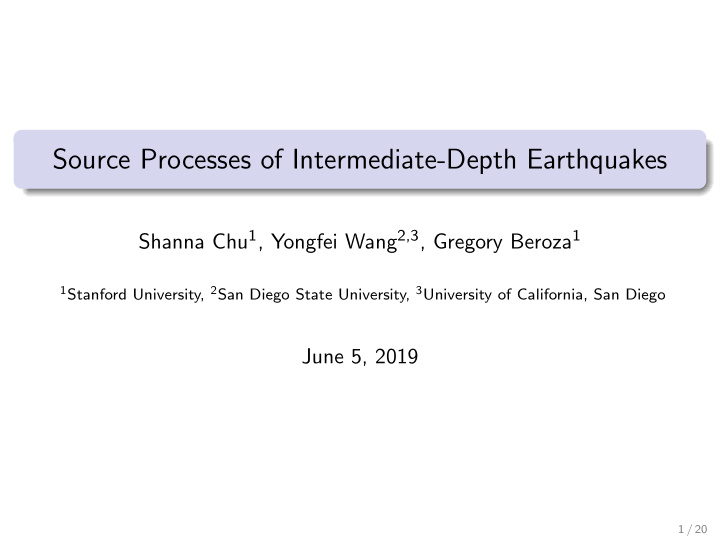



Source Processes of Intermediate-Depth Earthquakes Shanna Chu 1 , Yongfei Wang 2,3 , Gregory Beroza 1 1 Stanford University, 2 San Diego State University, 3 University of California, San Diego June 5, 2019 1 / 20
Overview of Research I use Blue Waters to simulate intermediate-depth earthquakes. Figure: Green, 2017 2 / 20
Overview of Research We need a different mechanism to nucleate earthquakes at intermediate depths (7-300 km) because pressure is very high (need to overcome high frictional strength!) temperature is very high (flow stress is low...we expect ductile deformation) Figure: Berkeley Science Review 3 / 20
Overview of Research We need a different mechanism to nucleate earthquakes at intermediate depths (7-300 km) because pressure is very high (need to overcome high frictional strength!) temperature is very high (flow stress is low...we expect ductile deformation) 4 / 20
Key Challenges Data for intermediate-depth earthquakes is scant in comparison to other earthquakes. Hence, solution to the inverse problem is non-unique Proper physical model does not exist! Data inversion usually performed assuming behavior similar to shallow earthquakes. Idea How can we incorporate hypotheses about intermediate-depth earthquake nucleation into numerical modelling and tie these to data? 5 / 20
Key Challenges We are also interested in how these earthquakes behave from small to large scales - a change in this behavior would represent a departure from shallow earthquakes. Figure: Chu et al., 2019 6 / 20
Why it matters Figure: M8.0 Peru 05/26/2019, USGS ShakeMap 7 / 20
Why it matters Not occurring on known faults! Reccurrence/location? Earthquake s pectral models key to understanding ground motion for structural engineering Blue Waters can help! We can use dynamic rupture models to study larger intermediate depth earthquakes with more realistic physical models. 8 / 20
Code Details We used SORD (support-operator rupture dynamics), a staggered-grid split-node code as detailed in Ely, Day and Minter (GJI 2009). SORD has been modified by Yongfei Wang also to include hybrid OpenMP/MPI (new on Blue Waters) 9 / 20
Results Dynamic simulation of the 145 km deep, 2006 Oita-Chubu event, M 6.4 Figure: Map from Nagumo and Sasatani (2006), RHS shows final slip vectors and slip contours over time 10 / 20
Results Dynamic simulation of the 145 km deep, 2006 Oita-Chubu event, M 6.4 Figure: Map from Nagumo and Sasatani (2006), RHS shows snapshots of slip. 11 / 20
But could be improved Figure: Harris, et al., SRL 2018 12 / 20
Remember these proposed mechanisms? 13 / 20
Intermediate-depth earthquakes have been hypothesized to display different physics... � µ s − ( µ s − µ d ) D / D c D ≤ D c f ( D ) = (1) µ d D > D c Figure: Marone and Saffer 14 / 20
This means different friction laws Figure: Liao and Reches, 2013 15 / 20
Some are harder to compute than others We can solve two coupled PDEs at each node, and time step ∂ 2 T ∂ T ∂ z 2 + ω ( z , t ) ∂ t = α th (2) ρ c ∂ 2 p ∂ p ∂ z 2 + Λ ∂ T ∂ t = α hy (3) ∂ t 16 / 20
Some are harder to compute than others We can solve two coupled PDEs at each node, and time step ✘✘✘✘✘✘✘✘✘✘✘✘ ❳❳❳❳❳❳❳❳❳❳❳❳ ∂ 2 T ∂ T ∂ z 2 + ω ( z , t ) ∂ t = α th (4) ρ c ❳❳❳❳❳❳❳❳❳❳ ✘ ∂ 2 p ✘✘✘✘✘✘✘✘✘✘ ∂ p ∂ z 2 + Λ ∂ T ∂ t = α hy (5) ∂ t ❳ but it’s possible to approximate the old friction law nonlinearly... √ π Λ f ( � α hy t + √ α th t ) 4 ρ c D c = (6) 17 / 20
Figure: Google Images 18 / 20
Summary We used Blue Waters to simulate a large intermediate depth earthquake (M6.5), with a complicated rupture We are implementing alternative friction laws in our model, to better approximate the mechanics hypothesized for intermediate-depth earthquakes Blue Waters allows us to study larger intermediate-depth earthquakes, with better incorporation of physics We also hope to extend this analysis to more intermediate-depth earthquakes 19 / 20
Acknowledgements I would like to thank the NCSA and the Blue Waters team for giving me this opportunity, Scott Lathrop, Ryan Mokos (POC), everyone who answered my JIRA tickets... 20 / 20
Recommend
More recommend